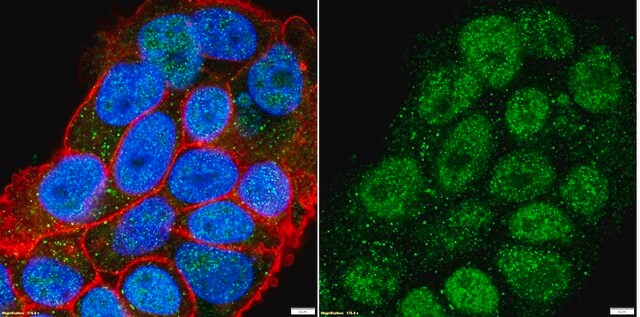E1528
Estrogen Receptor-α human
≥80% (SDS-PAGE), recombinant, expressed in baculovirus infected insect cells, buffered aqueous glycerol solution
Iniciar sesiónpara Ver la Fijación de precios por contrato y de la organización
About This Item
Productos recomendados
recombinante
expressed in baculovirus infected insect cells
Nivel de calidad
Análisis
≥80% (SDS-PAGE)
formulario
buffered aqueous glycerol solution
mol peso
66.4 kDa
envase
vial of 211 pmol
Nº de acceso UniProt
Condiciones de envío
dry ice
temp. de almacenamiento
−70°C
Información sobre el gen
human ... ESR1(2099)
Acciones bioquímicas o fisiológicas
Hormone-inducible transcription factor capable of acting positively or negatively in regulating genes involved in tissue growth and differentiation. For use in signal transduction, steroid biochemistry, and endocrine disruptor research.
Forma física
Solution in 50 mM Tris-HCl, pH 8.0, 500 mM KCl, 2 mM DTT, 1 mM EDTA, 1 mM orthovanadate, and 10% glycerol.
Código de clase de almacenamiento
12 - Non Combustible Liquids
Clase de riesgo para el agua (WGK)
WGK 3
Punto de inflamabilidad (°F)
Not applicable
Punto de inflamabilidad (°C)
Not applicable
Certificados de análisis (COA)
Busque Certificados de análisis (COA) introduciendo el número de lote del producto. Los números de lote se encuentran en la etiqueta del producto después de las palabras «Lot» o «Batch»
¿Ya tiene este producto?
Encuentre la documentación para los productos que ha comprado recientemente en la Biblioteca de documentos.
G G Kuiper et al.
Proceedings of the National Academy of Sciences of the United States of America, 93(12), 5925-5930 (1996-06-11)
We have cloned a novel member of the nuclear receptor superfamily. The cDNA of clone 29 was isolated from a rat prostate cDNA library and it encodes a protein of 485 amino acid residues with a calculated molecular weight of
G G Kuiper et al.
Endocrinology, 138(3), 863-870 (1997-03-01)
The rat estrogen receptor (ER) exists as two subtypes, ER alpha and ER beta, which differ in the C-terminal ligand binding domain and in the N-terminal transactivation domain. In this study we investigated the messenger RNA expression of both ER
K Paech et al.
Science (New York, N.Y.), 277(5331), 1508-1510 (1997-09-05)
The transactivation properties of the two estrogen receptors, ERalpha and ERbeta, were examined with different ligands in the context of an estrogen response element and an AP1 element. ERalpha and ERbeta were shown to signal in opposite ways when complexed
S Mosselman et al.
FEBS letters, 392(1), 49-53 (1996-08-19)
A novel estrogen receptor (hereinafter referred to as ER beta) was cloned using degenerate PCR primers. A comparison of the amino acid sequence of ER beta with the "classical' ER (ER alpha) shows a high degree of conservation of the
Nuestro equipo de científicos tiene experiencia en todas las áreas de investigación: Ciencias de la vida, Ciencia de los materiales, Síntesis química, Cromatografía, Analítica y muchas otras.
Póngase en contacto con el Servicio técnico





